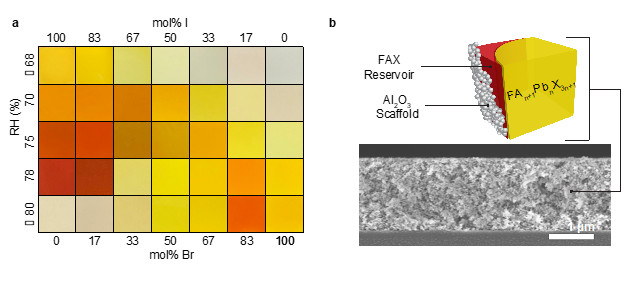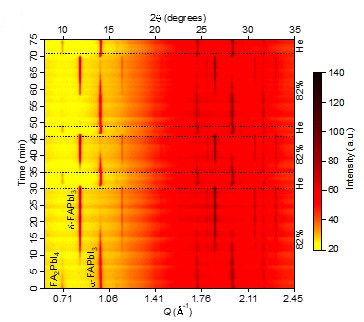Improving the energy efficiency of both residential and commercial buildings is a crucial step towards reducing CO2 emissions and preventing irreversible climate change. Windows pose a major weakness in terms of energy efficiency due to heat generated by solar irradiation, requiring energy-intensive air conditioning to compensate the heating. Conventionally, shutters are used during the day to avoid glare due to direct sunlight and to help with maintaining a moderate temperature inside the building. Switchable windows provide a more modern approach to the problem: these sheets of glass are transparent at room temperature and turn dark upon heating, providing a balanced tradeoff between the beneficial effects of transparent windows for the inhabitant/ user and preventing excessive heat generation and glare.

Fig. 1 | FAn+1PbnX3n+1 composite film characterization and reversible chromism. (a) Representative optical photographs of composite FAn+1PbnX3n+1 films highlighting the diverse colors obtainable upon exposure to humidity. (b) Illustration showing the components of a FAn+1PbnX3n+1 composite film including FAn+1PbnX3n+1, FAX reservoir, and Al2O3 NP scaffold. FA = formamidinium.
Recently a team of researchers from NREL, SLAC, and the Colorado School of Mines found a way to use hydrogen bond (H-bond) donor/acceptor molecules to trigger the transition between multiple colored and transparent phases in MHP films (Fig. 1a). These trigger molecules (water, methanol, ethanol, isopropanol) shuttle alkylammonium halide salts between MHP domains and adjacent alkylammonium halide “reservoir” domains (Fig. 1b). Reducing the concentration of the trigger molecule, i.e. decreasing the humidity in case of water as trigger molecule, reverses the phase transitions and reestablishes the original state.

Fig. 2 | Structural evolution during reversible hygrochromic cycling. In situ WAXS data collected on a FAn+1PbnI3n+1 composite film over three cycles of alternating exposure to 82% RH and He flow.
In situ wide angle x-ray scattering (WAXS) data was collected at SSRL beam line 11-3, probing the hydrochromism, i.e. utilizing water as trigger molecule for phase changes. In Fig. 2, these phase changes are visible in the diffraction pattern, repeatedly and reversibly cycling though the phase transition from the photo-active, opaque α-FAPbI3 phase to the photo-inactive, visibly transparent δ-FAPbI3 phase. In addition to the 3D α-FAPbI3 phase, 2D FAn+1PbnI3n+1 layers are detected by the WAXS at low angles. These species result from excess FAX separating 2D metal halide layers. The degree of separation can be controlled by modulating the equilibrium interactions between FAn+1PbnI3n+1 layers, FAI (formamidinium iodide) reservoir, and solvent vapor through changing the strength and number of H-bonds in the system.
Particularly remarkable is the multicolor chromism in these films: With the application in residential and commercial buildings in mind, the aesthetics of these photovoltaic windows play a significant role. Therefore, controlling MPHs ability to switch between a variety of colors, including yellow, orange, red, brown, and white/colorless is highly encouraging for future commercialization of these switchable photovoltaic windows.
This research is funded by the Department of Energy’s Building Technologies Office.
B. A. Rosales, L. E. Mundt, T. G. Allen, D. T. Moore, K. J. Prince, C. A. Wolden, G. Rumbles, L. T. Schelhas and L. M. Wheeler, "Reversible Multicolor Chromism in Layered Formamidinium Metal Halide Perovskites", Nat. Commun. 11, 5234 (2020) doi: 10.1038/s41467-020-19009-z.




